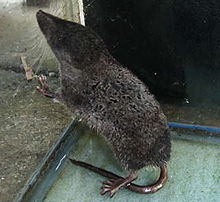Species of mammal
Japanese water shrew
Conservation status
Least Concern (IUCN 3.1 )[1]
Scientific classification
Kingdom:
Animalia
Phylum:
Chordata
Class:
Mammalia
Order:
Eulipotyphla
Family:
Soricidae
Genus:
Chimarrogale
Species:
C. platycephalus
Binomial name
Chimarrogale platycephalus Temminck , 1842
Japanese water shrew range
The Japanese water shrew (Chimarrogale platycephalus ), also called the flat-headed water shrew , is a species of mammal in the family Soricidae . It is endemic to Japan anese Islands, Honshu and Kyushu. They are considered extinct in Shikoku.[2]
Description [ ] The Japanese water shrew grows to a length of about 11 to 14 cm (4 to 6 in) long with a tail length of 8 to 12 cm (3 to 5 in) and weight of 25 to 63 grams (0.88 to 2.22 oz). The dense short fur on the head, back and sides is greyish-black. The underparts are dirty white and are sharply demarcated from the dorsal surface. Sometimes they are tinged with rusty brown or occasionally are entirely dark grey. There is a white spot just behind the eye and often another near the small, rounded ear which is nearly hidden in the fur. The nose is black and the snout long and tapering.
The Japanese water shrew inhabits mountain streams, small rivers and ponds, preying on benthic organisms, such as aquatic insects, crabs, shrimp, and small fish.[3]
See also [ ] References [ ]
^ Cassola, F. (2016). "Chimarrogale platycephalus " . IUCN Red List of Threatened Species 2016 : e.T40615A22282290. doi :10.2305/IUCN.UK.2016-2.RLTS.T40615A22282290.en . Retrieved 12 November 2021 . ^ Yamazaki, Haruka; Sekiya, Tomohiro; Nagayama, Shun; Hirasawa, Kei; Tokura, Keita; Sasaki, Akio; Ichiyanagi, Hidetaka; Tojo, Koji (2020-08-01). "Development of microsatellite markers for a soricid water shrew, Chimarrogale platycephalus, and their successful use for individual identification" . Genes & Genetic Systems . 95 (4): 201–210. doi :10.1266/ggs.20-00017 . ISSN 1341-7568 . ^ Yamazaki, Haruka; Sekiya, Tomohiro; Nagayama, Shun; Hirasawa, Kei; Tokura, Keita; Sasaki, Akio; Ichiyanagi, Hidetaka; Tojo, Koji (2020-08-01). "Development of microsatellite markers for a soricid water shrew, Chimarrogale platycephalus, and their successful use for individual identification" . Genes & Genetic Systems . 95 (4): 201–210. doi :10.1266/ggs.20-00017 . ISSN 1341-7568 .
Kingdom: Animalia
Phylum: Chordata
Class: Mammalia
Infraclass: Eutheria
Superorder: Laurasiatheria
Family: Erinaceidae subfamily: Erinaceinae
Atelerix Erinaceus
Amur hedgehog (E. amurensis ) Southern white-breasted hedgehog (E. concolor ) West European hedgehog (E. europaeus ) Northern white-breasted hedgehog (E. roumanicus ) Hemiechinus
Long-eared hedgehog (H. auritus ) Indian long-eared hedgehog (H. collaris ) Mesechinus Paraechinus
Family: Erinaceidae subfamily: Galericinae
Echinosorex Hylomys
Long-eared gymnure (H. megalotis ) Dwarf gymnure (H. parvus ) Short-tailed gymnure (H. suillus ) Neohylomys
Hainan gymnure (N. hainanensis ) Neotetracus
Shrew gymnure (N. sinensis ) Podogymnura
Dinagat gymnure (P. aureospinula ) Mindanao gymnure (P. truei )
Family: Soricidae subfamily: Crocidurinae
Crocidura (White-toothed
Family: Soricidae subfamily: Crocidurinae (continued)
Diplomesodon
Piebald shrew (D. pulchellum ) Feroculus Palawanosorex Paracrocidura (Large-headed Ruwenzorisorex
Ruwenzori shrew (R. suncoides ) Scutisorex Solisorex Suncus Sylvisorex (Forest shrews)
Family: Soricidae subfamily: Soricinae
Anourosorex (Asian mole shrews)
Blarinellini
Blarina (American short-tailed Cryptotis (Small-eared
Nectogalini
Chimarrogale (Asiatic water Chodsigoa Episoriculus Nectogale
Elegant water shrew (N. elegans ) Neomys
Mediterranean water shrew (N. anomalus ) Eurasian water shrew (N. fodiens ) Transcaucasian water shrew (N. teres ) Soriculus
Himalayan shrew (S. nigrescens )
Notiosoricini
Family: Soricidae subfamily: Soricinae (tribe: Soricini )
Sorex (Long-tailed
Subgenus
Long-tailed shrew (S. dispar ) Smoky shrew (S. fumeus ) American pygmy shrew (S. hoyi ) Large-toothed shrew (S. macrodon ) Carmen mountain shrew (S. milleri ) Dwarf shrew (S. nanus ) Mexican long-tailed shrew (S. oreopolus ) Orizaba long-tailed shrew (S. orizabae ) Ornate shrew (S. ornatus ) Inyo shrew (S. tenellus ) Verapaz shrew (S. veraepacis ) S. vagrans complexGlacier Bay water shrew (S. alaskanus ) Baird's shrew (S. bairdii ) Marsh shrew (S. bendirii ) Montane shrew (S. monticolus ) New Mexico shrew (S. neomexicanus ) Pacific shrew (S. pacificus ) American water shrew (S. palustris ) Fog shrew (S. sonomae ) Vagrant shrew (S. vagrans ) S. cinereus groupKamchatka shrew (S. camtschatica ) Cinereus shrew (S. cinereus ) Prairie shrew (S. haydeni ) Saint Lawrence Island shrew (S. jacksoni ) Paramushir shrew (S. leucogaster ) Southeastern shrew (S. longirostris ) Mount Lyell shrew (S. lyelli ) Portenko's shrew (S. portenkoi ) Preble's shrew (S. preblei ) Pribilof Island shrew (S. pribilofensis ) Olympic shrew (S. rohweri ) Barren ground shrew (S. ugyunak ) Subgenus incertae sedis
Family: Soricidae subfamily: Myosoricinae
Congosorex (Congo shrews) Myosorex (Mouse shrews) Surdisorex (African mole
Scalopinae (New World moles
Condylura
Star-nosed mole (C. cristata ) Parascalops
Hairy-tailed mole (P. breweri ) Scalopus
Eastern mole (S. aquaticus ) Scapanulus Scapanus (Western North
Talpinae (Old World moles
Euroscaptor Mogera
Echigo mole (M. etigo ) Insular mole (M. insularis ) Kano mole (M. kanoana ) Kobe mole (M. kobeae ) Small Japanese mole (M. imaizumii ) Large mole (M. robusta ) Sado mole (M. tokudae ) Japanese mole (M. wogura ) Senkaku mole (M. uchidai ) Parascaptor Scaptochirus
Short-faced mole (S. moschatus ) Talpa Scaptonyx
Long-tailed mole (S. fusicaudus ) Desmana
Russian desman (D. moschata ) Galemys
Pyrenean desman (G. pyrenaicus ) Dymecodon Urotrichus
Japanese shrew mole (U. talpoides ) Neurotrichus
American shrew mole (N. gibbsii )
Uropsilinae (Chinese shrew-like
Solenodon
Cuban solenodon (S. cubanus ) Hispaniolan solenodon (S. paradoxus )


 Media related to Chimarrogale platycephalus at Wikimedia Commons
Media related to Chimarrogale platycephalus at Wikimedia Commons